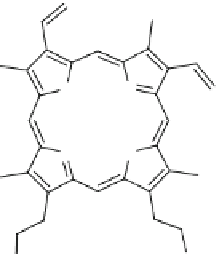Biomedical Engineering Reference
In-Depth Information
O
O
H
2
N
H
3
N
CO
2
CO
2
H
Fig. 6
5-Aminolevulinic acid (5-ALA) and its corresponding zwitterionic form
Fig. 7
Protoporphyrin IX
(Pp IX)
NH
N
HN
N
CO
2
H
CO
2
H
(Fig.
7
) is the immediate precursor to haem, and thus PpIX can be considered as a
natural photosensitizer. 5-Aminolevulinic and Photofrin® are the most widely used
PS in clinical practice. However, its zwitterionic nature at physiological pH and its
hydrophilicity limit its penetration through cell membranes. Oo et al. used AuNps
as nano-carriers for target delivery of 5-ALA to cancer cells. 5-ALA molecules were
immobilized at the surface of AuNPs through electrostatic interactions between the
carboxylate group of 5-ALA and positively charged surface of AuNPs. Incubation
experiments of 5-ALA-AuNPs conjugates with normal cells (fibroblasts) or cancer
cells (fibrosarcoma cells) showed their biocompatibility with negligible cytotoxic
effects. A greater uptake was observed for the cancer cells (more than threefold) and
maximum accumulation of PpIX was observed 24 h after the addition of 5-ALA-
AuNPs conjugates (fivefold higher in cancer cells). ROS production was investi-
gated after 4 h of incubation and 1 min of light irradiation. ROS production was
twofold higher in cancer cells treated with of 5-ALA-AuNPs conjugates and the
survival percentage of cancer cells decreased of about 30%
versus
60% with 5-ALA
alone. Moreover, co-culture experiments using both cell lines showed that interest-
ingly cancer cells were selectively destroyed. The higher ROS production in the
presence of 5-ALA-AuNPs conjugates may be explained by the surface plasmonic
effect of AuNPs and the enhancement of the photocurrent between the AuNPs and
the PpIX after light irradiation leading to the energy transfer to PpIX molecules.
Photothermia therapy can be used to increase the effectiveness of other cancer
treatments. In particular, it can increase the cellular uptake of oxygen molecules
which is essential for PDT. Synthesis, characterization, cellular uptake and photody-
namic activity of gold nanorods coupled to a photosensitizer have been described by
Kuo et al. (
2009, 2010
). They coated gold nanorods with a cetyltrimethylammonium









Search WWH ::

Custom Search